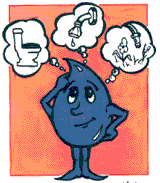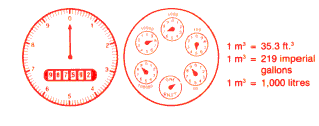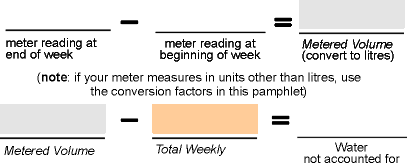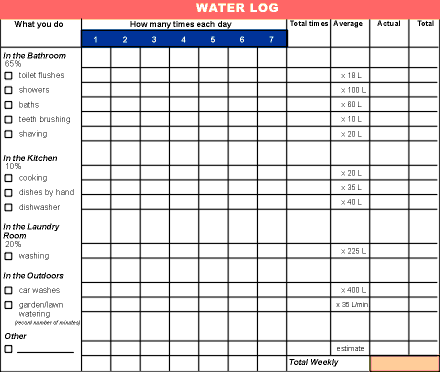Water Audit
How much water do you use?When you fill a glass with water, you know exactly how much water you have used. But do you know how much water it takes to flush a toilet, run a dishwasher, take a shower, or water your lawn? Your water meter says it allYour water meter measures the total amount of water used by your home. First, locate your water meter. Most meters are installed at the property line. Determine whether the meter measures in cubic metres (m3), cubic feet or gallons (this information will be displayed on the front face of the meter).  To measure water use in your home, take a meter reading just before and just after you flush the toilet, take a shower, or run the dishwasher. Make sure that no one else in the house is using water during your experiment or your reading will be incorrect. It is best to measure appliance water use by taking readings from your meter. Measuring water flow
To measure the flow rate, turn on your tap to the setting you normally use. Hold a graduated container under the faucet for a total of ten seconds. Measure the amount of water collected and multiply this amount by six to get the volume per minute. For example if you collected 1.7 litres in ten seconds when testing your showerhead, then the flow rate is 1.7 x 6 = 10.2 litres per minute. You can use this method to measure water use during showers, baths, brushing your teeth, watering your lawn, or washing your car. Just multiply the time spent on each activity by the flow rate calculated for the tap used. Therefore, if you take a five-minute shower you would use 5 x 10.2 = 51 litres of water. Measuring toilet waterCarefully shut off the valve in the toilet tank supply line. Don't force the valve or you may actually break it off, causing a flood. Then mark the water level in the tank reservoir. Flush the toilet. Now, re-fill the tank reservoir to the marked level using a graduated container to determine how much water is needed to flush the toilet. Once you've completed this task, don't forget to open the valve under the toilet. Why pay for water you don't use?
If the reading is significantly different the next morning you may have a leak somewhere. Consult a plumber and repair the leak immediately. Find out how much water you useYou would probably be amazed at the amount of water you actually use. If you're interested in finding out, try keeping track of your water use over the course of a week. Fill in the attached Water Log to help you to pinpoint areas where water savings could be easily achieved. Meter anyone?You don't need a water meter to complete a water log, but if you have one, you can use it to compare the amount you calculate on your Water Log with the amount you've actually used. Here's how... read your meter at the beginning of the week and again one week later. Note these readings below. Subtract the Total Weekly amount (taken from the last line on your Water Log) from your Metered Volume to find out how much water has been used that hasn't been accounted for in your log.  
We'd like to know...Print a copy of the Water Log. Keep a copy for your records and use this information to calculate water and dollar savings as you learn to use water wisely! Please share your information with us by returning to completed form
to: REMEMBER, the WISE USE OF WATER will save you money and help improve the environment.  An environmental citizen uses water
wisely |